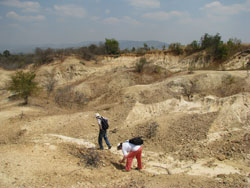
Dr. Willoughby and Ben Collins at Kigwambimbi
Congratulations to Dr. Pamela Willoughby, who received a SSHRC Standard Research Grant in the October 2010 competition.
Title: "The Evolution of modern humans in southern Tanzania: Further investigations by the Iringa Region Archaeological Project". SSHRC Standard Research Grant #410-2001-0117; from April 1, 2011 to March 31, 2014.
Applicants: Dr. Pamela R. Willoughby, Department of Anthropology, University of Alberta, Principal Investigator. Dr. Katie Biittner, Department of Anthropology, University of Alberta, Collaborator. Dr. Pastory Bushozi, Department of History and Archaeology, University of Dar es Salaam, Collaborator. Dr. Anne Skinner, Department of Chemistry, Williams College, Collaborator. Dr. Christopher Stringer, Department of Palaeontology, Natural History Museum, London, Collaborator. (Note: Collaborator is used by SSHRC for researchers with PhDs who participate in the research but who are not based at a Canadian university).
Brief Description: Most geneticists and specialists in human evolution are convinced that our own species, Homo sapiens, or anatomically modern people, evolved in Africa sometime around 200,000 years ago. But they only migrated out of the continent between 60,000 and 40,000 years ago. Earlier humans dispersed out of Africa; why not us? These earliest modern humans are associated with Middle Palaeolithic or Middle Stone Age (MSA) flake tools, ones that are virtually indistinguishable from those produced by people in Eurasia, such as the Neanderthals. In Europe, the first anatomically modern people appeared after 40,000 years ago, and are accompanied by revolutionary innovations in technology, including the first figurines, jewellery, bone and ivory tools. These Upper Palaeolithic innovations are seen as proof of more complex behaviours. Richard Klein of Stanford University argues that all Middle Palaeolithic people were incapable of complex social behaviour, even though the Africans were already anatomically indistinguishable from us today. Only late in the MSA, he believes, did some of them suddenly developed neurological adaptations for true language and symbolically-based culture. Then they became behaviourally modern, developed LSA / Upper Palaeolithic technologies, and rapidly spread into Eurasia, replacing the indigenous people along the way.
In order to understand the origins and evolution of our earliest behaviourally modern ancestors, research must focus on sites in sub-Saharan Africa. However, the end of the MSA (or beginning of the Later Stone Age or LSA) is almost invisible, as it is associated with extremely harsh glacial conditions that saw a general reduction in human settlement throughout the continent. People may have only survived in refuge areas; one of these is likely to be the highlands of southern Tanzania, where our ongoing field research programme has documented a long record of MSA, LSA and more recent occupation. In order to prove this, we have organized a team of experts to provide precise dates for our sites. This will allow us to see if Iringa preserves a record of the Middle to Later Stone Age transition, as well as evidence of occupation during the extremely cold phases of the late ice age, when large parts of Africa were abandoned. Studies of a sediment core from nearby lakes show no real change in forest cover for the last 50,000 years. So, despite the high elevation, this region remained hospitable to human life.
The granite rockshelters and eroded gullies of the Iringa Region of southern Tanzania hold a long record of human history, extending from the late Acheulean around 300,000 years ago to the 21st century. In the first season, members of IRAP or the Iringa Region Archaeological Project will focus on dating the archaeological sequences we have already uncovered. The goal is to identify whether or not a MSA to LSA transition is present and whether or not this was the period when the first signs of technological innovation appear. A parallel initiative, CHIRP or the Cultural Heritage in Iringa Research Project, addresses the education of local people and Tanzanian government authorities about the history of this region of southern Tanzania.